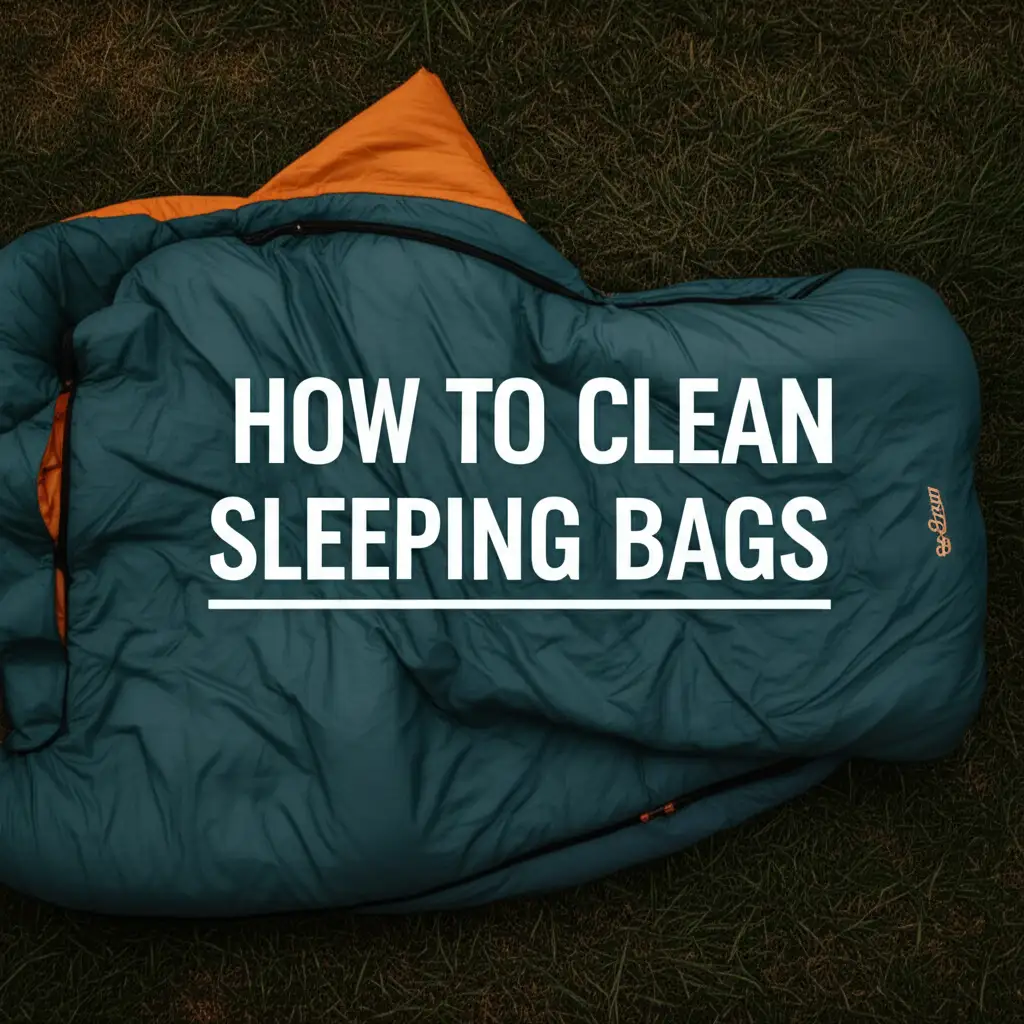· Outdoor Gear Care · 15 min read
How To Clean Sleeping Bags

Restore Your Rest: How To Clean Sleeping Bags Effectively
A clean sleeping bag is key to comfortable nights outdoors. Dust, sweat, and dirt build up over time. This makes your bag less effective and comfortable. Learning how to clean sleeping bags correctly saves you money. It also keeps your gear performing at its best for years.
I know the struggle of keeping outdoor gear fresh. My own sleeping bags have seen countless adventures. Proper care makes a huge difference. This guide will walk you through the entire process. We will cover everything from understanding your bag type to drying and storage. Get ready to give your sleeping bag the refresh it deserves.
Takeaway
- Identify your sleeping bag’s insulation type (down or synthetic) before washing.
- Spot clean small stains and perform repairs before a full wash.
- Use a front-loading washing machine or hand wash in a tub.
- Select a gentle, technical cleaner suitable for your bag’s insulation.
- Dry your sleeping bag completely and patiently, especially down bags.
Cleaning a sleeping bag involves gentle washing with a specialized cleaner, careful rinsing, and thorough drying in a large, well-ventilated space, often with tennis balls to fluff insulation.
Why Cleaning Your Sleeping Bag Matters for Comfort and Longevity
Your sleeping bag is more than just a piece of gear. It is your cozy shelter in the wilderness. Over time, it collects sweat, body oils, dirt, and even campfire smoke. This buildup does more than just make your bag smell bad. It also impacts its insulation properties. Dirt and oils can weigh down the insulation, reducing its ability to trap warm air.
A dirty bag is less efficient at keeping you warm. It compresses more easily, creating cold spots. Regular cleaning helps your sleeping bag keep its loft. This means it stays fluffy and warm. It also extends the lifespan of your expensive outdoor investment. A clean bag also prevents mold and mildew growth. These can ruin your bag permanently. I have seen many bags go bad due to improper care. Keeping your sleeping bag clean ensures pleasant sleep. It also ensures it is ready for your next adventure.
Cleaning protects the fabric and zippers. A build-up of grime can make zippers stick. It can also weaken the fabric over time. This leads to tears or worn spots. Cleaning your sleeping bag removes these damaging agents. This keeps all parts of your bag working well. Think of it as preventative maintenance for your comfort. It saves you from buying a new bag sooner than necessary.
Understanding Your Sleeping Bag Type: Down vs. Synthetic Insulation
Before you clean your sleeping bag, you must know its insulation type. Sleeping bags typically use either down or synthetic fill. Each type requires specific cleaning methods. Using the wrong method can damage the insulation. This reduces your bag’s warmth and lifespan. I learned this the hard way with my first down bag.
Down insulation uses feathers from ducks or geese. It is lightweight, very warm, and highly compressible. However, down loses its insulating power when wet. It also takes a long time to dry. Special detergents protect the natural oils in down. These oils help down maintain its loft. Standard detergents can strip these oils. This makes down clump and lose its insulating properties. Always check the care tag for specific instructions.
Synthetic insulation uses man-made fibers like polyester. It is more affordable and dries faster than down. Synthetic bags also retain some warmth when wet. They are generally more robust and easier to clean. You can often use a mild, gentle detergent for synthetic bags. They do not require the same specialized cleaners as down bags. Knowing your bag’s insulation type is the first critical step. This ensures you choose the right cleaning approach.
Preparation is Key: Pre-Cleaning Steps and Spot Treatment
Preparation makes the cleaning process much smoother. First, empty all pockets. Check for forgotten items like wrappers or headlamps. These items can damage your washing machine or bag during the wash cycle. Next, close all zippers and Velcro fasteners. This prevents snags and tears. It also helps maintain the bag’s shape. I always double-check these steps.
Inspect your sleeping bag for any tears or loose seams. It is best to repair these before washing. Washing can make small tears much larger. A simple needle and thread can fix most minor issues. Use a patch kit for larger holes. This prevents insulation from escaping during the wash. You want your bag to be as intact as possible.
Spot clean any visible stains before a full wash. Use a small amount of mild soap or a specialized stain remover. Apply it directly to the stain with a soft cloth. Gently rub the area. This targets specific dirty spots. Do not use harsh chemicals. For general stains, the principles of how to clean stains on wood can be loosely adapted; you apply a suitable cleaner, agitate gently, and rinse. Rinse the spot with clean water. Repeat if necessary. This pre-treatment helps ensure a thorough clean. It prevents stains from setting during the wash cycle.
Addressing Mold and Mildew
Sometimes, a sleeping bag can develop mold or mildew, especially if stored damp. This often appears as black or green spots and smells musty. You need to address mold immediately. For areas affected by mold, apply a solution of equal parts water and vinegar. Let it sit for a short time, then gently scrub the area. For tougher mold, a solution designed for how to clean mold off plastic might offer some insights into techniques, even if the materials differ. Rinse the spot thoroughly. Ensure the area is completely dry before proceeding with a full wash. Ignoring mold can lead to permanent damage and health issues.
How to Wash a Down Sleeping Bag: Machine and Hand Washing Methods
Washing a down sleeping bag requires careful attention. Down insulation is delicate. It clumps easily when wet. Always use a front-loading washing machine. Top-loaders with agitators are too harsh. They can damage the baffles and insulation. If you do not have a front-loader, hand washing is a good option. I prefer the front-loader when available.
Machine Washing Down Bags
- Select the Right Detergent: Use a specialized down wash or a mild, non-detergent soap. Brands like Nikwax or Granger’s make excellent products. Avoid regular laundry detergents. They strip the natural oils from down feathers. These oils keep down lofty and warm.
- Load the Machine: Place your sleeping bag alone in the washing machine.
- Set the Cycle: Choose a delicate or gentle cycle. Use cold water. Add an extra rinse cycle. This ensures all soap is removed. Residual soap can weigh down the feathers.
- Spin Cycle: After the wash, run multiple spin cycles. This removes as much water as possible. Your bag will still be heavy and wet. Be careful when removing it. Support its weight to prevent tearing.
Hand Washing Down Bags
Hand washing is a gentler alternative. It takes more effort but is very safe for your bag.
- Prepare a Tub: Fill a bathtub or large basin with lukewarm water.
- Add Detergent: Pour in the specialized down wash. Mix it into the water.
- Submerge the Bag: Gently submerge your sleeping bag. Squeeze out air pockets. Let it soak for 15-30 minutes.
- Gently Wash: Carefully knead the bag. Work the soapy water through the insulation. Do not scrub harshly.
- Rinse Thoroughly: Drain the soapy water. Refill the tub with clean, cold water. Gently press water through the bag. Repeat this rinsing process several times. You need to remove all soap residue. The water should run clear. This step is crucial.
- Squeeze Out Water: Carefully press out excess water. Do not wring the bag. Wringing can damage the baffles. Support the bag’s weight when moving it. It will be very heavy.
How to Wash a Synthetic Sleeping Bag: Machine and Hand Washing
Synthetic sleeping bags are generally easier to clean than down bags. Their fibers are more resilient to water. However, you still need to be gentle. Avoid harsh detergents and hot water. These can break down the synthetic fibers. Always check your bag’s care label.
Machine Washing Synthetic Bags
- Choose a Machine: Use a large front-loading washing machine. As with down bags, agitators in top-loaders can cause damage. The extra space in a commercial machine is often best.
- Select Detergent: Use a mild, non-detergent soap. Regular laundry detergent is usually fine. Make sure it is free of bleach or fabric softeners. These can harm the insulation. I use a gentle, fragrance-free liquid detergent.
- Load and Set Cycle: Place the bag alone in the washer. Set the machine to a gentle or delicate cycle. Use cold water. An extra rinse cycle is a good idea. This ensures no soap remains.
- Spin Cycle: Run an extra spin cycle. This helps remove excess water. The bag will be damp but not as heavy as a wet down bag. Take care when removing it from the machine.
Hand Washing Synthetic Bags
Hand washing is an excellent alternative if you lack a suitable machine. It provides full control over the cleaning process.
- Prepare a Basin: Fill a bathtub or large utility sink with cool or lukewarm water.
- Add Soap: Add a small amount of mild, non-detergent soap to the water. Swirl it to mix.
- Immerse the Bag: Submerge your synthetic sleeping bag completely. Gently press out any trapped air.
- Wash Gently: Lightly knead and squeeze the bag. Work the soapy water through the insulation. Focus on dirty areas. Avoid harsh scrubbing.
- Rinse Thoroughly: Drain the soapy water. Refill the tub with clean, cool water. Gently press clean water through the bag. Repeat until all soap is gone. The water should appear clear.
- Remove Water: Carefully press out as much water as possible. Do not twist or wring the bag. This can damage the fibers. Support the bag’s weight when lifting it. Synthetic bags are lighter when wet than down bags, but still fragile. When cleaning synthetic materials, remember that techniques for how to clean plastic shower often involve gentle scrubbing and thorough rinsing, principles that apply here too.
Drying Your Sleeping Bag Safely and Effectively
Drying a sleeping bag is the most crucial step. Improper drying can ruin your bag. Both down and synthetic bags need complete drying. This prevents mold, mildew, and loss of insulation. Patience is key in this stage. I learned to never rush drying a sleeping bag.
Drying Down Sleeping Bags
Down bags take a long time to dry. It can take several hours, even a full day.
- Low Heat or No Heat: Use a large commercial dryer if possible. Set it to the lowest heat setting or air fluff (no heat). High heat can melt the fabric or damage the down.
- Add Tennis Balls: Put 3-5 clean tennis balls or dryer balls into the dryer with your bag. These balls help break up clumps of wet down. They also fluff the insulation. This ensures even drying and restores loft.
- Regular Checks and Fluffing: Stop the dryer every 20-30 minutes. Remove the bag and gently pat and redistribute the down clumps. This is vital for even drying and loft recovery.
- Air Drying Finish: Once mostly dry in the dryer, hang the bag in a well-ventilated area. Continue to gently pat and fluff it periodically. Ensure there are no damp spots. This final air drying prevents residual moisture. It can take another day or two.
Drying Synthetic Sleeping Bags
Synthetic bags dry faster than down bags. However, thoroughness is still important.
- Low Heat Setting: Use a large dryer on a low heat setting. High heat can melt synthetic fibers. If you notice a plastic smell, reduce the heat immediately.
- Tennis Balls (Optional): You can use tennis balls for synthetic bags too. They help prevent clumping and speed drying. They also help distribute the insulation more evenly.
- Check for Dryness: Tumble dry until completely dry. Feel all parts of the bag. Check for any dampness. Even small damp spots can lead to mildew.
- Air Dry: For final assurance, lay the bag flat or hang it in a well-ventilated area for several hours. This ensures every fiber is dry. It prevents any musty odors from forming.
Dealing with Stubborn Stains and Lingering Odors
Even with a full wash, some stains or odors might persist. This is common with heavily used bags. Do not despair. There are specific methods to tackle these issues. I have had to deal with stubborn campfire smells many times.
Tackling Stubborn Stains
For stains that did not come out with the initial spot treatment:
- Re-treat Locally: Apply a small amount of specialized fabric cleaner directly to the stain. Gently work it in with a soft brush or cloth.
- Rinse and Repeat: Rinse the spot thoroughly with clean water. Repeat the process if the stain remains. Be patient.
- Enzyme Cleaners: For organic stains (food, blood), an enzyme-based cleaner can be very effective. Follow product instructions carefully. Always test on an inconspicuous area first.
Removing Lingering Odors
Sometimes a bag just smells musty or holds onto campfire smoke.
- Air Out Thoroughly: Hang the fully dry sleeping bag in a well-ventilated area for several days. Fresh air can do wonders. Outdoor drying on a sunny, breezy day is ideal.
- Odor Eliminators: Use fabric-safe odor eliminator sprays. Look for products designed for outdoor gear. These often contain enzymes that break down odor-causing molecules.
- Vinegar Soak (for synthetic): For very strong odors in synthetic bags, a short soak in a dilute vinegar solution can help. Mix one part white vinegar with ten parts water. Submerge the bag for 30 minutes, then re-wash. For general odor neutralization, the method of how to clean walls with vinegar can offer a similar principle: using vinegar’s acidic properties to neutralize odors. Always rinse thoroughly afterward.
- Baking Soda: Sprinkle baking soda inside the bag. Let it sit for a few hours or overnight. Then vacuum it out. Baking soda absorbs odors.
Post-Cleaning Care and Storage for Your Sleeping Bag
Once your sleeping bag is perfectly clean and dry, proper post-cleaning care is essential. It ensures your bag stays in top condition for years to come. This final stage is just as important as the cleaning itself. Many people overlook this step.
Restoring Loft and Airing Out
After drying, your down bag should be fluffy again. Synthetic bags will also regain their loft. Give the bag a good shake and gentle fluffing. This helps distribute the insulation evenly. It also restores the bag’s full insulating power. Then, hang the bag in a well-ventilated space for at least 24 hours. This allows any residual moisture to evaporate. It ensures the bag is completely dry before storage. This step is crucial to prevent mold and mildew growth.
Proper Storage Techniques
Never store your sleeping bag compressed in its stuff sack for long periods. Compression flattens the insulation over time. This reduces its ability to loft and keep you warm. Long-term storage requires space.
- Storage Bag: Use a large mesh storage sack or a cotton laundry bag. These bags allow air circulation. They prevent the insulation from becoming compressed. Most sleeping bags come with a larger storage sack specifically for this purpose.
- Hang It: If space allows, hang your sleeping bag in a closet. Use a wide hanger to avoid stressing one area of the bag.
- Loose Storage: If you cannot hang it, store it loosely in a large, clean bin or under a bed. Ensure it is not crushed by other items.
- Cool, Dry Place: Choose a cool, dry place for storage. Avoid basements, attics, or garages. These areas often have temperature fluctuations or high humidity. Humidity can lead to mold and mildew.
Regularly check your stored bag. Pull it out and give it a shake. This helps maintain its loft and freshness. Proper storage extends your sleeping bag’s life. It ensures it is ready for your next adventure.
Frequently Asked Questions About Cleaning Sleeping Bags
How often should I clean my sleeping bag?
You should wash your sleeping bag only when it is visibly dirty or smells. Over-washing can reduce its lifespan. For light use, once a year might be enough. For heavy use, you may need to wash it more often. Spot clean minor stains between full washes.
Can I wash my sleeping bag in a top-loading washing machine?
No, do not use a top-loading washing machine with an agitator. The agitator is too harsh. It can damage the insulation and baffles of your sleeping bag. Always use a front-loading machine or hand wash. This protects your bag’s integrity.
What kind of detergent should I use for down sleeping bags?
Use a specialized down wash like Nikwax Down Wash Direct or Granger’s Down Wash. These detergents protect the natural oils in the down feathers. Regular detergents strip these oils. This causes the down to clump and lose its insulating properties.
How long does it take for a down sleeping bag to dry completely?
A down sleeping bag can take many hours to dry, sometimes even a full day or two. You must use a low heat setting in a large dryer with tennis balls. Stop and fluff the bag every 20-30 minutes. Ensure it is completely dry to prevent mold and mildew.
Can I use fabric softener or bleach on my sleeping bag?
No, never use fabric softener or bleach on your sleeping bag. Fabric softener can clog the insulation, reducing its loft and warmth. Bleach can damage the fabric and insulation permanently. Stick to mild, specialized cleaners.
How do I store my sleeping bag between trips?
Store your sleeping bag loosely, not compressed in its stuff sack. Use a large mesh or cotton storage sack. You can hang it in a closet or keep it in a large bin. Store it in a cool, dry place. This prevents compression and maintains loft.
Conclusion
Cleaning your sleeping bag might seem like a daunting task. However, it is a simple process. Following these steps ensures your gear stays in top condition. You protect your investment by keeping it clean. My own experiences taught me the value of proper sleeping bag care. A clean bag means better sleep outdoors.
Remember to identify your bag’s insulation type. Use the right washing method and detergent. Take extra care during the drying phase. Always store your sleeping bag loosely and in a cool, dry place. These habits keep your bag performing its best. They also extend its life for many adventures to come. Get ready for fresh, comfortable nights under the stars. Your clean sleeping bag awaits its next journey with you.
- sleeping bag care
- down sleeping bag
- synthetic sleeping bag
- outdoor gear
- laundry tips




